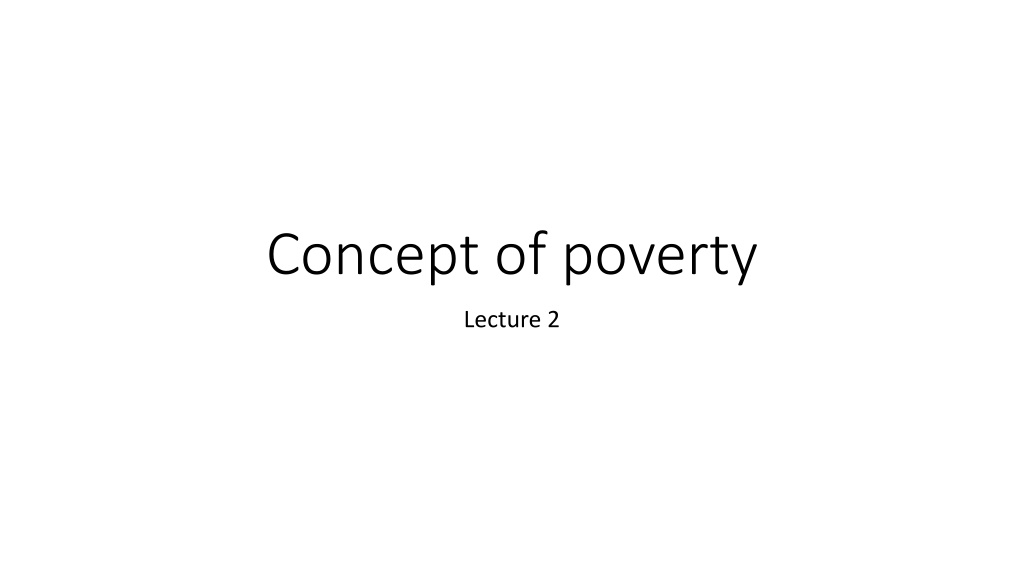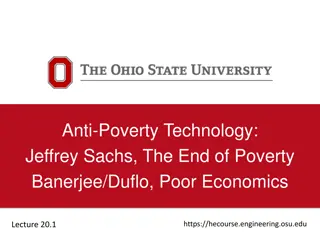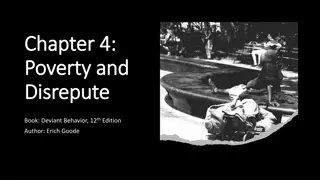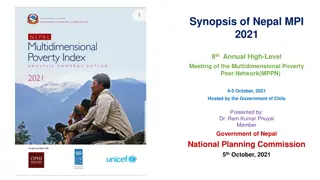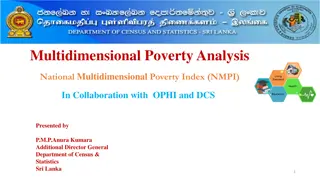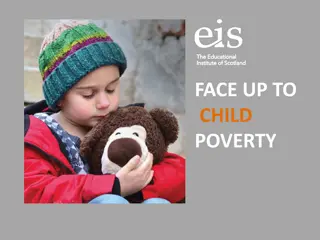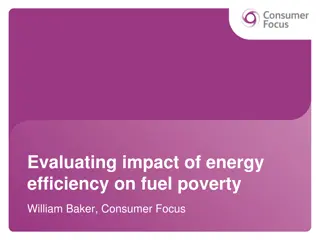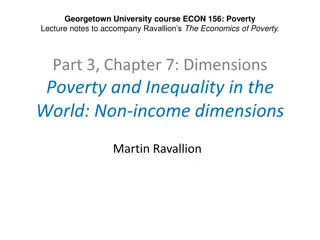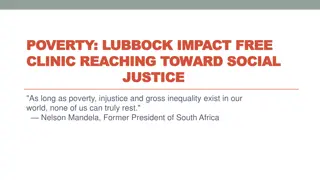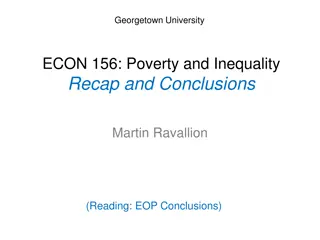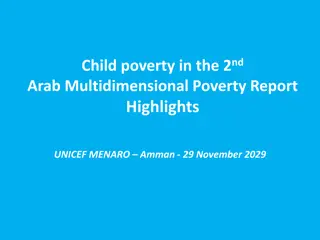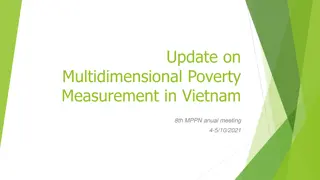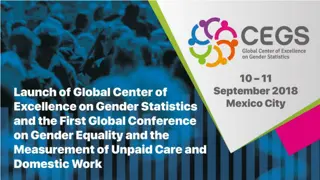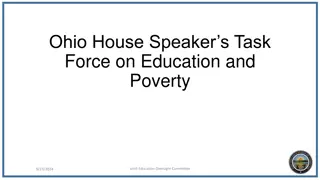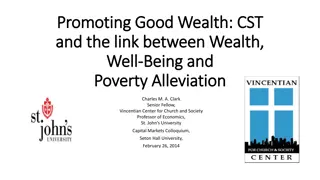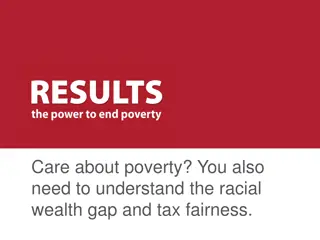Understanding Poverty: Definitions and Dimensions
In this lecture, the concept of poverty is explored, covering definitions, characteristics, and sociological perspectives. It delves into absolute and relative poverty distinctions, global poverty lines, and the multidimensional nature of poverty as outlined by the United Nations. The discussion emphasizes how poverty impacts individuals, families, and communities, affecting their basic needs, opportunities, and human dignity.
Download Presentation

Please find below an Image/Link to download the presentation.
The content on the website is provided AS IS for your information and personal use only. It may not be sold, licensed, or shared on other websites without obtaining consent from the author. Download presentation by click this link. If you encounter any issues during the download, it is possible that the publisher has removed the file from their server.
E N D
Presentation Transcript
Concept of poverty Lecture 2
Learning objectives To describe/define the concept of poverty To explain the characteristics of poverty and its dynamic nature To use some sociological approaches to describe poverty
Definition of poverty Definition of poverty In general, poverty is seen as economic deprivations experienced by poor people in their daily lives Poverty is defined by the World Bank as a pronounced deprivation in well- being . It can be defined narrowly or more broadly, depending on how well-being is understood. Narrow definitions of well-being are typically linked to commodities, i.e. whether households or individuals have enough resources to meet their needs. In this case poverty is seen largely in monetary terms in relation to household s income or consumption. Income and consumption are generally defined at household level and do not take account of intra- household variations which obscures individual poverty. Broader definitions of well-being include items such as physical and mental health, close relationships, agency and participation, social connections, competence and self-worth, and values and meaning
Absolute Absolute Vs Vs Relative poverty Relative poverty Absolute poverty is poverty below an official line (poverty line) set at the absolute standard of what households should be able to count on in order to meet their basic needs . The most commonly used global comparative poverty lines were USD 1.25 (updated in October 2015 to USD 1.90) and USD 2.00 (updated to USD 3.10) a day.
Monthly ceiling in Czech Republic Monthly ceiling in Czech Republic
Relative poverty Relative poverty is defined in relation to other people in that society at the same time. Poverty is often defined this way in high-income countries to acknowledge that people are part of a society and to take into account broader quality of life issues (Hulme, 2010).
Poverty as a multidimensional phenomenon Poverty as a multidimensional phenomenon United Nations Definition of Poverty Fundamentally, poverty is a denial of choices and opportunities, a violation of human dignity. It means lack of basic capacity to participate effectively in society. It means not having enough to feed and cloth[e] a family, not having a school or clinic to go to, not having the land on which to grow one s food or a job to earn one s living, not having access to credit. It means insecurity, powerlessness and exclusion of individuals, households and communities. It means susceptibility to violence, and it often implies living on marginal or fragile environments, without access to clean water or sanitation.
Three dimensions of poverty Three dimensions of poverty
Health Nutrition: deprived if any adult or child for whom there is nutritional information is malnourished Child mortality: deprived if any child has died in the family Education Years of schooling: deprived if no household member has completed five years of schooling Child enrolment: deprived if any school-aged child is not attending school in years 1 to 8 Standard of Living Cooking fuel: deprived if they cook with wood, charcoal or dung Sanitation: deprived if they do not have an improved toilet or if their toilet is shared Drinking water: deprived if the household does not have access to clean drinking water or clean water is more than 30 minutes walk from home Electricity: deprived if the household has no electricity Flooring: deprived if the household has dirt, sand or dung floor Assets: deprived if the household does not own more than one of: radio, TV, telephone, bike, or motorbike, and do not own a car or tractor (Alkire and Santos, 2010, p. 2).
Some important terminologies to further conceptualize of poverty Some important terminologies to further conceptualize of poverty Shelter poverty, food poverty, asset poverty, time-poverty or health poverty refer to lack of that specific good The transiently poor move in and out of poverty The chronically poor are poor for years at a time or even their whole lives Vulnerability to poverty is the probability or risk of being in poverty or falling into poverty in the future
Poverty as capability deprivation Poverty as capability deprivation As articulated by Amartya Sen (1987), looks at well-being arising through people s ability to function in society. Poverty arises when people lack key capabilities and so have inadequate income or education, or poor health, or insecurity, or low self-confidence, or a sense of powerlessness, or the absence of rights such as freedom of speech (Haughton & Khandker, 2009, p. 2-3). Viewed in this way, poverty is a multidimensional phenomenon and less agreeable to simple solutions. For instance, while higher average incomes will certainly help reduce poverty, these may need to be accompanied by measures to empower the poor, or insure them against risks, or to address specific weaknesses such as inadequate availability of schools or a corrupt health service.
Poverty as a culture Poverty as a culture American anthropologists, Oscar Lewis developed the Theory of culture of poverty (Five Families: Mexican Case Studies in the Culture of Poverty, 1959) He stated that being in poverty tends to create a way of living that becomes a culture of its own or subculture He tired to capture the way of behaving and thinking of poor in comparison to middle class people This culture is learned, shared and transmitted as a behavior of a social group Culture of poverty proposed that approximately 20% of poor people are trapped in cycles of self-perpetuating behavior that caused poverty.
Culture of poverty contains Culture of poverty contains More specifically, 70 behavioral traits or characteristics are identified with those who have a culture of poverty. These characteristics include weak ego structure strong present-time orientation confusion of sexual identification Strong feeling of marginality, helplessness, dependency, inferiority (Oscar Lewis, 1958) Lewis received many criticisms
For your consideration Do you think that poverty can be prevented by giving the poor money/subsidies Talk to few poor people/families (3-5) and try to capture Characteristics of their poverty Their perspectives on their poverty Reasons Suggestions to overcome
Haughton, J., & Khandker, S. R. (2009). Handbook on poverty and inequality. Washington, DC: World Bank
